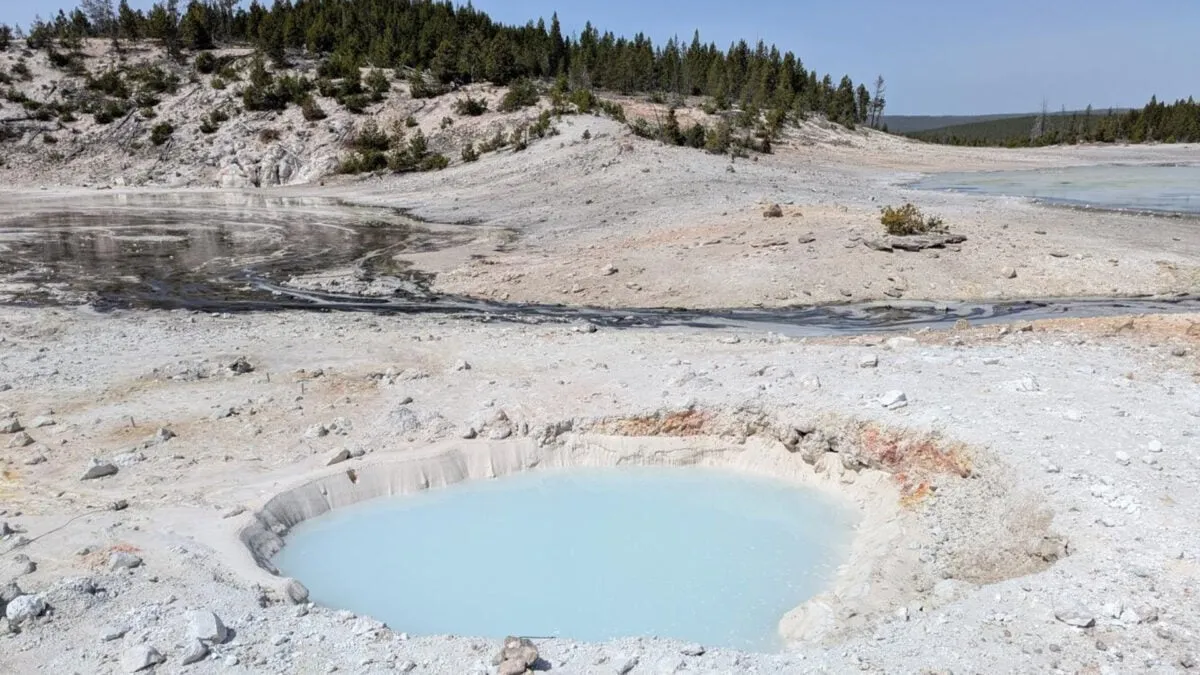
In April 2023, geologists engaged in routine maintenance at temperature logging stations in Yellowstone National Park’s Norris Geyser Basin made a remarkable discovery: a previously undocumented thermal pool of stunning blue water. This newly identified pool, located within the Porcelain Basin subbasin, measures approximately 13 feet (4 meters) in width and boasts a water temperature of around 109 degrees Fahrenheit (43 degrees Celsius). According to a statement from the United States Geological Survey, the surface of the water is situated about one foot (30 centimeters) below the rim of the pool, surrounded by light-gray mud-covered rocks, some reaching widths of up to one foot (30 cm).
The formation of this intriguing thermal feature has piqued the interest of geologists. Based on the evidence gathered, they propose that the pool likely formed due to a hydrothermal explosion. This phenomenon occurs when liquid water transforms into steam, leading to changes in underground pressure that can trigger a steam blast. Hydrothermal explosions are not uncommon in the Norris Geyser Basin, which has a history of similar events. Notable instances include the 1989 explosion of Porkchop Geyser, showcasing the area's dynamic geothermal activity.
In 2023, a new monitoring station was established that detected an explosion in the Porcelain Terrace area on April 15, 2024. Satellite imagery indicates that the newly formed pool did not exist prior to December 19, 2024. By January 6, 2025, a small cavity began to emerge, and by February 13, the water pool had completely formed. Interestingly, the monitoring station, which utilizes infrasound technology to detect hydrothermal activity, did not register any significant explosions during this period. However, it did capture several weak acoustic signals originating from the pool’s direction on December 25, 2024, January 15, 2025, and February 11, 2025, although these lacked the seismic signals typically associated with strong explosions.
It appears that the pool's formation likely resulted from a series of smaller explosions that ejected rocks and silica mud, rather than a single large event. The process likely began on December 25, 2024, and continued throughout January and early February of the following year, allowing silica-rich water to fill the cavity created by these smaller explosions.
The Norris Geyser Basin is recognized as the oldest and most active thermal area in Yellowstone National Park, home to the tallest geyser on the planet—a sporadically explosive hot water spring. Yellowstone itself features over 10,000 thermal features, including geysers, hot springs, steam vents, and mudpots, making it a major attraction for tourists and scientists from around the world. The geothermal activity in this region is fueled by an underground magma reservoir, part of the vast Yellowstone volcano complex, which heats groundwater and initiates a range of chemical and physical reactions.
This recent discovery not only highlights the ongoing geological processes at play in Yellowstone but also serves as a reminder that even the most extensively studied landscapes can still yield surprising findings. The emergence of this new thermal pool in the Norris Geyser Basin underscores the dynamic nature of the park’s geothermal features and the importance of continued monitoring and research in understanding these natural phenomena.